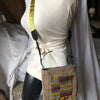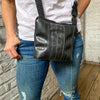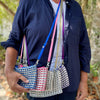The Circular Fashion Economy: An Eco-Friendly Paradigm Shift Toward a Greener Future

Being a global contender in waste production, the fashion industry is notorious for its environmental footprint. With the rise in environmental awareness, sustainability isn't just a buzzword anymore–it defines a new era of fashion, the Circular Fashion Economy.
What if we could take old clothes and transform them into new? What if we could eliminate fashion waste and create an industry that comes full circle? That's exactly what the Circular Fashion Economy aims to do.
What is the Circular Fashion Economy?
To understand the circular fashion economy, it is necessary to demystify two terms: 'circular' and 'fashion economy.' The term 'circular' implies a system of production and consumption that involves sharing, leasing, reusing, repairing, refurbishing, and recycling existing materials and products as long as possible. On the other hand, 'fashion economy' refers to the economic system revolving around the production, distribution, and consumption of clothes, shoes, and accessories.
Therefore, the circular fashion economy involves a transformative approach towards designing, sourcing, producing, and consuming fashion that maximizes economic, social, and environmental value and minimizes waste throughout the system.
The 4 R's of Circular Fashion
The Circular Fashion Economy is guided by the principal 4 R's: Reduce, Reuse, Recycle, and Repair.
- Reduce: Minimizes waste, water, and energy usage during the manufacturing and distribution processes. The idea is to produce less but with better quality and durability.
- Reuse: Advocates for wearing pre-loved clothes through vintage shops, clothing swaps, and companies that offer clothes rental services.
- Recycle: Encourages innovation in turning old clothes into new, thereby reducing the need for virgin resources.
- Repair: Supports mending and altering to extend a garment's lifeline.
Real-Life Examples of Circularity in Fashion
A perfect example of circularity in fashion is the Swedish brand H&M's garment collecting program, which accepts any clothes, from any brand, in any condition. They either sell them as second-hand, turn them into other products like cleaning cloths, or grind down and use in insulation.
Additionally, the leading Spanish fashion retailer Zara launched its first sustainable clothing line, 'Join Life,' which includes clothes made from recycled wool, organic cotton, and Tencel - a material known for its environmentally friendly manufacturing process.
The Role of Circular Fashion Policy
An effective Circular Fashion Policy is essential to accelerate the industry's transition towards circularity. It promotes waste reduction, inspires innovative design, encourages sustainable production practices, and urges transparency and accountability in the fashion sector.
A Sustainable Shift Toward a Greener Future
The shift towards a circular fashion economy is more than just a change in manufacturing processes—it’s a holistic system change. The transition is driving advances in technology and complex supply chain adaptations but most importantly, it’s driving a change in culture.
Sustainability can no longer be a mere marketing tool, it must be ingrained into the fashion DNA, from design and manufacturing to shipping and retail. This will aid in conserving resources, reducing waste, and creating a healthier and safer environment for all.
In conclusion, the circular fashion economy provides a solid framework for achieving sustainability in the fashion industry. It challenges everyone, from designers to consumers, to rethink and revolutionize the way we make, sell, and use clothes. As consumers become more informed, the demand for sustainable fashion will grow, ensuring that circular fashion isn’t just a passing trend, but a sustainable shift towards a greener future.
-
Posted in
circular fashion





